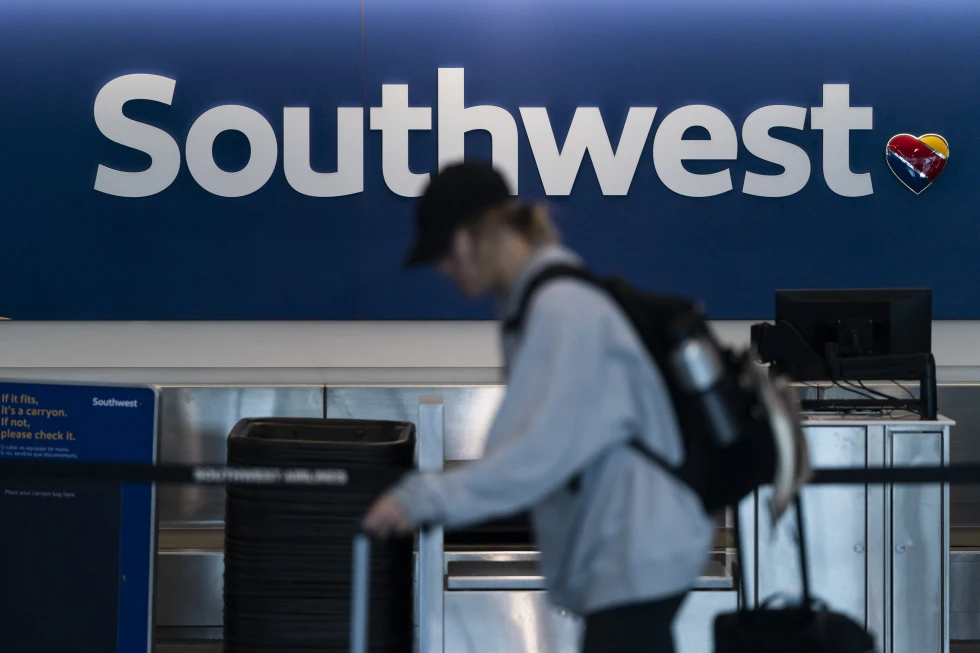Passengers Injured as Southwest Plane Dives Midair \ Newslooks \ Washington DC \ Mary Sidiqi \ Evening Edition \ A Southwest Airlines flight to Las Vegas took a sharp plunge shortly after takeoff from Burbank, California, due to a collision alert. Two flight attendants were injured, and passengers were shaken. The FAA is investigating the incident involving a military-style aircraft.
Quick Looks
- Southwest Flight 1496 plunged 300 feet in 36 seconds
- Incident followed a cockpit alert of a nearby aircraft
- Two flight attendants sustained injuries during turbulence
- Passenger described chaos and panic inside the cabin
- Woman not wearing seatbelt thrown from seat midair
- FAA confirms investigation into possible near miss
- Fighter-style Hawker Hunter Mk. 58 identified near incident
- Plane continued to Las Vegas and landed safely
- Southwest says pilot responded to dual system alerts
- Burbank Airport denies radar record of the dive
- Passengers shocked; comedian Jimmy Dore among eyewitnesses
- FAA and airline reviewing cockpit alert systems
- Follows a series of aviation safety scares in 2024
Deep Look
What was supposed to be a routine Southwest Airlines flight from Southern California to Las Vegas turned into a terrifying ordeal just moments after takeoff on Friday, when Flight 1496 experienced a sudden and sharp dive—later confirmed to be the result of a cockpit collision alert warning of a nearby aircraft. The incident left passengers panicked, two flight attendants injured, and federal aviation authorities launching a formal investigation into what could have become a catastrophic midair collision.
The flight, a Boeing 737 operating out of Hollywood Burbank Airport, departed just before noon. But within minutes of climbing into the skies over Los Angeles County, the aircraft dropped approximately 300 feet (91 meters) in just 36 seconds, according to publicly available flight data from FlightAware.
While some turbulence is expected during takeoff climbs, this descent was abrupt, extreme, and reactive—triggered by an onboard system alerting the pilot of a possible midair conflict. That system, the Traffic Collision Avoidance System (TCAS), is a critical onboard technology designed to detect nearby aircraft and recommend evasive action to prevent crashes.
Passenger Chaos and In-Flight Panic
For passengers inside the cabin, those 36 seconds felt far longer.
Stef Zamorano, a passenger on board with her husband, described the terrifying moment as something out of a movie. “The plane jolted hard, and then it felt like we were falling,” she told The Associated Press. “People screamed. A woman who wasn’t buckled shot out of her seat, and her hair was flying everywhere.”
Zamorano said that other passengers began visibly panicking. “The woman across from me said what we were all thinking: ‘I want to get off this plane. I want to be on the ground.’”
Even comedian and political commentator Jimmy Dore, also a passenger, shared his reaction in real-time on social media platform X. “Pilot said his collision warning went off & he needed to avoid a plane coming at us,” he wrote. The post sparked widespread concern and renewed debate about airspace safety and near-miss protocols.
The Collision Alert: Understanding TCAS
The near miss was prompted by a TCAS alert, a standard feature on commercial aircraft that monitors airspace within a 40-mile radius, detecting other aircraft with transponders and issuing warnings if any come too close.
In this case, Southwest confirmed that two separate alerts went off in the cockpit. The pilot was first instructed to climb, then descend—a rare double action which indicates significant concern for proximity safety. These alerts are automatically generated and are often considered non-negotiable by pilots due to their urgency.
Southwest’s statement to media noted that the crew followed all protocols and that the flight was never technically in danger. However, the sheer violence of the descent and the physical injuries incurred suggest otherwise.
A Mysterious Intruder: Hawker Hunter Mk. 58
According to flight radar logs, Flight 1496’s airspace may have intersected with a Hawker Hunter Mk. 58, a British-designed military fighter jet, also visible on tracking platforms shortly after noon in the same air corridor.
The Hawker Hunter, known for its Cold War-era agility and speed, is currently registered to Hawker Hunter Aviation, a British-based defense contractor. The company has not publicly responded to requests for comment regarding its aircraft’s position, why it was flying near a busy civilian airport, or whether it was under contract for a military or defense-related mission in U.S. airspace.
This development raises serious questions. Was the fighter jet properly cleared for airspace operations? Was it visible on radar to both air traffic control and commercial TCAS systems? And perhaps most crucially—how close did it actually come to colliding with the Southwest jet?
Airport Denial: Burbank Says No Record of Dive
Surprisingly, officials at Hollywood Burbank Airport said they have no record of the altitude drop. Mike Christensen, spokesperson for the airport, stated that neither the control tower nor the airport operations team logged any incident involving a sudden descent. “From our end, everything looked routine,” he told reporters.
This discrepancy may have more to do with how TCAS incidents are recorded than a failure of oversight. FAA radar systems can miss certain aircraft if they are flying low, are using non-standard transponders, or are in limited radar zones. Additionally, air traffic controllers typically only intervene if a pilot declares an emergency or requests priority landing.
That said, the FAA has launched a formal review and may audit local radar data to determine if the aircraft truly had a “near miss” and whether existing protocols were followed by all parties.
Injuries and Legal Implications
As a result of the sharp descent, two flight attendants were injured, though details about the extent of their injuries remain undisclosed. No passengers were reported to be seriously hurt, but the FAA is also likely to interview individuals who were thrown from their seats due to a lack of seatbelt use.
This adds to the ongoing campaign by airline safety advocates urging passengers to keep their seatbelts fastened even when the seatbelt sign is off. It’s a reminder that turbulence and evasive maneuvers can happen at any moment.
If injuries were found to be the result of a preventable error, Southwest could face civil liability or federal scrutiny depending on what the FAA investigation reveals.
A Broader Safety Concern
This event joins a troubling trend of near-miss aviation incidents reported across the U.S. in 2024. In January, a tragic midair collision over Washington, D.C. claimed 67 lives and exposed several failures in air traffic communication and enforcement. Since then, the FAA has faced increasing pressure from lawmakers, aviation unions, and the public to strengthen protocols and technology meant to prevent such occurrences.
The proximity of a military aircraft to a major commercial flight corridor will undoubtedly reignite debates over shared airspace usage, particularly when private defense contractors operate vintage or tactical aircraft in domestic skies.
Analysts also point to the strain on America’s air traffic control system, exacerbated by staffing shortages and outdated radar infrastructure, as contributing factors in close-call scenarios like these.
Looking Ahead: FAA Investigation and Industry Fallout
The FAA will likely take several steps in its review:
- Interview the Southwest pilots and crew
- Request and review TCAS logs and cockpit audio
- Confirm the identity and flight plan of the Hawker Hunter aircraft
- Audit radar and air traffic control records from Burbank
- Evaluate if proper protocols were followed by both aircraft
Southwest Airlines has said it is cooperating fully, and no mechanical issues were reported with the aircraft itself.
Whether the Hawker Hunter aircraft had clearance to operate in that airspace, or whether its flight path inadvertently triggered the collision warning, could determine whether future flights of such aircraft near urban hubs are restricted.
Passenger Aftermath and Psychological Impact
For those onboard, the experience may have been brief—but its emotional impact lingers.
“It felt like we were just going to fall out of the sky,” said Zamorano. “You never think it’s going to happen to you until it does.”
Many passengers were still visibly shaken upon landing in Las Vegas, despite the airline calling it an “uneventful arrival.” Some have since called for an open hearing or press release detailing what happened and why.
Final Thought
This incident, while not resulting in fatalities or a crash, underscores how narrow the margin for error is in modern aviation. It also highlights the critical role of automated warning systems like TCAS, and the pressures faced by pilots who must make split-second decisions based on alerts that could mean life or death.
As the FAA continues to investigate, one thing is clear: for the 100+ passengers on Flight 1496, this was a wake-up call about aviation safety—and the thin line between routine and catastrophe.
Passengers Injured as Passengers Injured as Passengers Injured as







